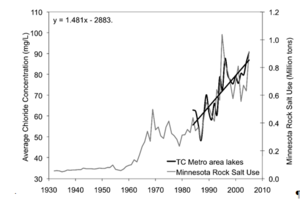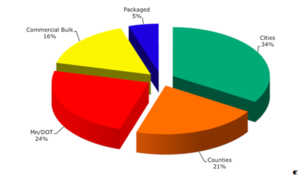
Winter Parking Lot and Sidewalk Maintenance Manual Revision as of 16:50, 1 February 2016 by PLeegar (talk | contribs) (→Water and Environmental Impacts)
Contents
Background Information
Good Business Choices
Customer service is the key to success. Best Management Practices (BMP) keep parking lots and sidewalks safe and also reduce environmental impacts. Educating customers on the proper methods of snow removal and ice control (and of the value of this approach) can create a good and long-standing relationship.
Customers want reliable service. Providing a well-planned and well-executed winter maintenance program will have a positive impact. Using the latest technologies will increase the abilty to provide reliable service.
Customers want to hire educated winter maintenance professionals. This maunal will provide the necessary information to increase staff knowledge on the best practices for winter maintenance.
Using the right amount of material at the right time, will save time and money.
Certification in Smart Salting is a good reflection on the professional and the organization.
Customers and the public want safe parking lots and sidewalks. Understanding the materials, weather and application rates, provide a head start on controlling icy, slippery parking lots, and sidewalks.
Clean and neat parking lots and sidewalks are important to the public. By using less material and increased winter sweeping, pedestrians will track less material into buildings and there will be less damage to flooring. Proper snow storage makes debris removal in the spring easier. Covered storage of deicers will reduce loss of material, protect water, and is more aesthetic. Using BMPs and lower application rates will keep parking lots and sidewalks looking neat.
Customers also want affordable snow and ice control. The use of sophisticated chemicals and equipment may require a larger budget up-front; however, these costs can be balanced by reduced on-going costs. Reducing the need for sweeping, floor and rug maintenance, parking lot striping, and snow and ice maintenance time will allow for cost savings.
Minnesotan’s value water resources and the protection of lakes, streams, and wetlands is important. Educating customers how sustainable winter maintenance protects water resources is necessary.
Using less material is an effective approach to protecting our water resources. It is difficult to recover salt or sand once applied.
Water and Environmental Impacts
- Only 2.5% of all of the water on this planet is freshwater (not saltwater). Of that, less than 1% is available for use. The majority of the freshwater is frozen in the glaciers (Freshwater Crisis n.d.).
- Water is recycled over long periods of time. There is a limited supply of water on this planet. Water is reused, recycled and dispersed as illustrated below from the Minnesota Department of Natural Resources (DNR), “Healthy Rivers: a Water Course” (Healthy Rivers 2004).
Chloride concentrations are increasing in many surface waters and groundwater across Minnesota.
- In the Twin Cities Metropolitan Area (TCMA), of surface water bodies tested, 39 are on the draft 2014 impaired waters list for chloride exceedances and 38 more are found to be at high risk as of July 2015. (MPCA 2015). Salts (chloride) dissolve in water and move with the water to nearby lakes, streams, and wetlands and also infiltrate into groundwater.
- Chloride is virtually a permanent pollutant that does not degrade and cannot be removed from surface waters. Once in the water, it continues to accumulate in the environment over time.
- Salt water is heavier than freshwater and may sink to the bottom of lakes. This may cause chemical stratification of the lake and loss of or changes in lake turn over (Stefan et al. 2008).
- Thirty percent of the 270 shallow aquifer monitoring wells tested in the TCMA exceeded the state chloride standard. (MPCA 2013).
- About 75% of Minnesotans rely on groundwater for drinking water. The MPCA has found 30% of the shallow monitoring wells, often found in urban areas, have exceeded the state standard for salt levels. As water moves from shallow to deeper aquifers, the salt contamination could penetrate sources of drinking water (MPCA 2013).
- The average salt use in the TCMA based on purchasing records is 349,000 tons per year (Sander et al. 2007).
Deicers can be very damaging to both soil and vegetation. Efforts to keep salt off vegetation are needed: drive slower when applying deicers, turn down spinner speed to reduce spread pattern, use drop spreaders on sidewalks, store snow piles on hard surfaces, and reduce application rates. One source of information about salt-tolerant plants is the Plant Selector from Minnesota Department of Transportation.
Impacts of Materials
Abrasives and deicers cause problems to infrastructure, drainage, water, vegetation, and soils when used in large quantities. Abrasives: Winter Sand
- Runs off parking lots with water to the nearest storm drain entering lakes, wetlands, streams, and rivers.
- Fills in surface water bodies, accelerating the aging process.
- Covers habitat and disrupts the food chain.
- Irritates the gills of fish.
- Clogs and disrupts the flow of water in storm drain systems.
Deicers are not "environmentally safe" regardless of what the bag says.
Chlorides commonly used for deicing are Sodium Chloride (road salt), Magnesium Chloride, Calcium Chloride, and Potassium Chloride.
- Road salt is the least expensive and most widely used deicer.
- Salt is corrosive to steel.
- Some have corrosion inhibitors and anti-caking agents added that are often toxic.
- Frequently damage plants through contact or by interfering with soil properties.
- Salt can cause soil to lose its ability to retain water, leading to soil erosion.
- Excess salt can make soil more alkaline and compact, and less permeable, making it more difficult to store nutrients that plants need to grow.
- Cannot be removed by stormwater ponds or rain gardens.
- Cannot be removed from the lakes, wetlands and rivers.
- Are persistent pollutants and will not break down over time.
About one teaspoon of salt can pollute five gallons of water. This applies to all chloride containing deicers.


